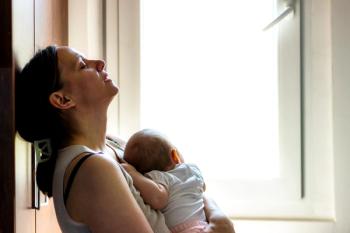
- Vol 39, Issue 4
Here’s How the COVID-19 Pandemic Is Shaping the Next Generation
How have the past 2 years affected our youth? The full picture is just beginning to emerge.
The full picture of teenagers’ experience of COVID-19 is just beginning to emerge. The school closures, canceled proms, and separation from friends seemed a small price to pay to save the lives of thousands—but in exchange, the adolescents who represent the younger side of Generation Z were robbed of the capstone of their formative years. It created an atmosphere of uncertainty and anxiety among some teens, about both the future and their place in it.
As if the pandemic was not enough, teens watched as police violence and racial tensions reached breaking points. They saw angry mobs take over cities and storm the Capitol. Then Mother Nature swept in with deadly wildfires and other natural disasters that underscored the threat of climate change.
Throughout COVID-19, the physical health needs of the most vulnerable often took priority over the mental health needs of others. But as the pandemic dragged on, health care providers expressed concern over its long-term mental effects on youth and teens. Against expectations, suicide rates for all ages dropped by 5.6% in 2020 compared with 2019.1 This is not entirely unusual. In what is known as the “pulling together” effect, suicide rates tend to dip during shared experiences of catastrophe. Nonetheless, despite this decline, there are indications that the pandemic has triggered a ripple of mental health concerns across all age groups.
When the shelter-in-place measures went into effect in late March 2020, trips to the emergency department (ED) for anything other than COVID-19 plummeted by 42% across all ages.2 Yet while these non–COVID-19 trips declined, the proportion of ED trips for psychosocial issues actually increased by 69%.2 Children and teens experienced increases of about 24% and 31%, respectively.2 Further, there were troubling indications that suicide-related ED visits by girls were significantly higher than those of boys.3 In summer 2020, these visits for attempted suicide rose 26% among girls aged 12 to 17 years compared with 2019.4
The “New Normal”
A September 2020 poll found that 59% of teenagers considered online school worse than in-person instruction, with 19% describing it as “much worse.”5 One survey found that half of US teenagers were experiencing anxiety, trouble concentrating, and social isolation/loneliness during remote learning.6 Also in the survey, 31% of parents reported that their child’s emotional health was worse than before the pandemic. About 53% worried that their children would contract COVID-19 if they went back to school the following fall. Another 36% worried that their mental health would suffer if they did not.6
Interestingly, parents were more likely to notice new or worsening symptoms of depression and anxiety in teen girls.6 In July/August 2020, the number of girls admitted to the ED for suspected suicide attempts had increased 26.2% over a year prior.4 In February/March 2021, this rate was now 50.6% higher.4 Among boys, this rate had increased as well, but by 3.7%.4 These were troubling statistics, especially since suicide is the second-leading cause of death among youths aged 10 to 17 years.7 In 2019, almost 19% of high school students in the United States had seriously considered suicide, 15.7% made an attempt plan, and 8.9% reported attempting suicide at least once.3
For many teens, COVID-19 took away coping strategies like after school clubs and visiting friends—activities that have always had a positive impact on depression, anxiety, and chronic health conditions.8 Ironically, remote learning did provide some protections for teens, namely against bullying, which is more commonly done in person. The results of one study indicated that online searches for “school bullying” and “cyberbullying” dropped by 30% to 40% in spring 2020 and maintained this level through the following winter.9 As students gradually returned to school, however, internet searches about bullying increased.9
Alcohol and marijuana consumption among 12th-graders remained stable during 2020.10 This indicated that even though the pandemic created perceived barriers to access, teenagers could still acquire these substances.10 Nicotine vaping, however, declined from 24% before the pandemic compared with 17%.10
Effects on Minority Youths
A Centers for Disease Control and Prevention (CDC) report in October 2020 acknowledged that virtual education, compared with in-person education, presented more risks to the mental and emotional well-being of both parents and children.8 Children spent less time outside, less time with friends, and less time exercising because of it.8
Children in Black, Latino, and multiracial families were particularly impacted, as they were more likely to receive virtual instruction compared with white children.8 Parents of remote-learning children were also more likely to report loss of work, job stability concerns, child care challenges, emotional distress, and difficulty sleeping.8
Latino adults reported a higher prevalence of stress in relation to food, housing, and job insecurity.11 Racial tension, protests, and riots added another layer of stress within Black, Indigenous, and people of color communities, where more than half of teens worried about dealing with racial justice issues at school.12
Asian Americans and Pacific Islanders were experiencing their own version of racism, as many others ignorantly held them responsible for the spread of COVID-19.13 No less than 81% of Asian Americans and Pacific Islanders felt that violence against them was increasing in 2020.13
The pandemic has affected just about every teenager in some way. Cut off from their peers, there was little opportunity to socialize and commiserate in person. It is only natural that young people turned to social media to connect with others. In fact, 36% of teenagers found that social media helped them cope with the pandemic.12
Social Media’s Influence
Prior to March 2020, 26% of students spent 4 to 8 hours a day on social media.12 That shot up to 39% during the lockdown periods of the pandemic.12 Aware that social media were among the few available ways to connect, many families relaxed their rules on screen time, with 81% saying it helped their children.14 Social media provided teens and younger children with comfort, inspiration, and something to do. Kids learned the latest TikTok dance, perfected making whipped coffee, and collectively laughed as school fun easily transitioned to online platforms.
A survey of teens taken between September and November 2020 revealed that 53% credited social media as “very important” to keeping them connected to friends and family.15 Among individuals aged 14 to 22 years, 43% said social media helped them feel better when they were depressed, stressed, or anxious—up from 27% in 2018.15 It was also where most of them got their news. A 2019 survey discovered that 54% of teens relied on social media and 50% on YouTube for information.16 When the murder of George Floyd and the killing of Breonna Taylor by police ignited racial unrest, teens turned to their phones to keep up-to-date.
But there was also a dark side to social media. A month after police Floyd’s death, the “George Floyd Challenge” encouraged some teens to recreate scenes of the crime and post them on social media. For youth who identified as Black or Indigenous or a person of color, it was a stark reminder of how powerful and hurtful social media can be. According to a survey, 69% of Black youth and 67% of Hispanic youths reported encountering racist content online.15 They were not the only ones.
About 74% of youth who identified as lesbian, gay, bisexual, transgender, and queer (LGBTQ) said they encountered homophobic content on social media. Gender and sexual identity were major topics of discussion in 2020, with almost a quarter of youths identifying themselves as some form of nonbinary gender.15 At 65%, LGBTQ youth were twice as likely to report symptoms of moderate to severe depression as non-LGBTQ youth.15 When 92% of them searched for health information online, the most common topics were COVID-19 and anxiety.15
Girls continued to be exposed to the harsh side of social media. Body dissatisfaction and body shaming played out online, with 53% of girls exposed to at least 1 form of weight stigmatization.17 Eating disorders were also on the rise. The number of adolescents aged 12 to 18 years admitted to a hospital for an eating disorder increased by 25% from March 2020. This was mainly attributed to girls, who experienced a 30% increase, compared with boys at 4%.18
Back-to-School Anxiety
By fall 2021, the prevalence of depression and anxiety in children and adolescents around the world had doubled from prepandemic levels to 25.2% and 20.5%, respectively.19 Symptoms were noted at higher levels later in the pandemic, especially in girls and older teens.19
With COVID-19 infection rates constantly fluctuating, schools and communities debated, hesitated, and grappled with the decision to reopen schools for in-person learning. The city of San Francisco had to sue its own school district in March 2021 to force it to open its doors to students, citing a loss in learning and mental health concerns.20
When students returned to school in fall 2021, only 31% felt emotionally prepared to socialize in person, 20% felt they would succeed in school, and 28% felt they would be able to focus on learning.12 Adding to the back-to-school jitters, 3 in 4 teens were worried about contracting COVID-19 during in-person school, according to a survey.21
Anxiety and depression continue to be the most common mental health conditions among teens, with 1 in 3 adolescents meeting the criteria for anxiety by age 18 years.22 But there is growing discussion over whether the COVID-19 pandemic qualifies as a traumatic event. If so, this will affect how clinicians approach and treat patients.
Pandemic PTSD
Posttraumatic stress disorder (PTSD) can occur when people have experienced or witnessed a traumatic event in which lives and personal safety have been threatened. It involves 4 categories of symptoms (
Currently, the pandemic does not quite fit the criteria set within DSM-5. Qualifying traumatic events are generally direct events that happened in the past, and much of the trauma experienced during the pandemic has, instead, been the result of indirect reactions to what might happen in the future.23 For instance, there were teens who lost family members to COVID-19, an event that could meet the standards for PTSD. But what about waking up every day to news that thousands of people were dying from a ruthless virus and that you could be next?24
The sheer number of COVID-19 deaths was 4 times higher than the number of American casualties killed in the Vietnam War.24 In the news constantly, COVID-19 dominated our lives and conversations. Teens and adults alike worried that they would either contract the disease or inadvertently infect someone else. Surely this fear—heightened and prolonged as it was—could qualify as a traumatic event.24
PTSD’s symptoms of intrusive thoughts and heightened arousal were certainly present.23 One June 2020 survey by the CDC indicated that 26.3% of respondents had symptoms of trauma and stressor-related disorders related to the pandemic.25 Another study found that 13.2% of participants had PTSD symptoms even though their triggering events, such as being in lockdown, did not technically fit the description of trauma.23 Through it all, teens endured the fear, uncertainty, and suffering largely alone, isolated from friends. In fact, during the pandemic,
Trauma-Informed Care
In its simplest terms, trauma is what happens when an event challenges a person’s ability to cope.
During childhood, parents and caregivers can help build this resilience by reassuring kids that they are safe, establishing healthy routines, and regulating their own emotions so they can help their children do the same.28 This reflecting or leading by example was understandably difficult for many families during COVID-19. No one knew what to expect, and the shifting sands of the pandemic created feelings of panic that were hard to control.
Children and adolescents who experience stress early in life are particularly susceptible to psychiatric vulnerability.27 This refers to the cognitive structures that can make people more fragile to stress.27 It is also why 75% of all mental illnesses are established by age 24 years.29
One 2020 study compared brain scans and surveys of teenagers before and after the pandemic. It found that a teen’s ability to manage the pandemic’s challenges depends in part on the fortitude of their executive functions, the skills used to navigate life on a daily basis. Increased connectivity in the brain’s frontal lobe indicated greater resilience.30 As youth experience challenges, the love, reassurance, and support they receive from families, friends, and social networks can provide a protective factor that can build resilience. Higher socioeconomic status and education also provide protections.27 Knowing that we are not alone can provide the comfort we need to build resilience.
Concluding Thoughts
In many ways, today’s teenagers are vastly different from who they were before the pandemic. The best years of their lives were thrown into chaos, and it is going to take some time to recover.
Together, they have collectively shared a major life event—one that is sure to impact how their resilience evolves. On the cusp of adulthood, these teens still need lots of love, reassurance, patience, and positive examples. Parents can provide this by checking in with their teens, listening more, and acknowledging that even grownups get overwhelmed. Maintaining connections with others and sharing their thoughts is often the best way to diffuse pent-up feelings. By being open and honest, they can teach resilience to their children.
COVID-19 continues to exert a powerful influence on the lives of everyone, and time will tell how this experience will shape the way today’s teenagers live, work, and feel in the years and decades to come. It is up to us to help them reset and take action in their lives.
Dr Abenes is a licensed clinical psychologist for Mindpath Health and an advocate for the AAPI community as a Filipino woman leader.
References
1. Ahmad FB, Anderson RN.
2. Leeb RT, Bitsko RH, Radhakrishnan L, et al.
3. Ridout KK, Alavi M, Ridout SJ, et al.
4. Yard E, Radhakrishnan L, Ballesteros MF, et al.
5. New survey: majority of teens say online learning is worse than in-person, but only 19% think school should return to full in-person instruction. Common Sense Media. September 16, 2020. Accessed November 9, 2021.
6. Fluent family wellbeing study. JED Foundation. December 2020. Accessed November 9, 2021.
7. Ivey-Stephenson AZ, Demissie Z, Crosby AE, et al.
8. Verlenden JV, Pampati S, Rasberry CN, et al.
9. Bacher-Hicks A, Goodman J, Greif Green J, Holt MK. The COVID-19 pandemic disrupted both school bullying and cyberbullying. Annenberg Institute at Brown University. July 2021. Accessed November 9, 2021.
10. Adolescent marijuana, alcohol use held steady during COVID-19 pandemic. News release. National Institutes of Health; June 24, 2021. Accessed November 9, 2021.
11. McKnight-Eily LR, Okoro CA, Strine TW, et al.
12. BlueSky back-to-school survey 2021. Blue California. 2021. Accessed November 9, 2021.
13. Ruiz NG, Edwards K, Lopez MH. One-third of Asian Americans fear threats, physical attacks and most say violence against them is rising. Pew Research Center. April 21, 2021. Accessed November 9, 2021.
14. Mott Poll report: how the pandemic has impacted teen mental health. CS Mott Children’s Hospital, University of Michigan Health. March 15, 2021. Accessed November 9, 2021.
15. Coping with COVID-19: how young people use digital media to manage their mental health. Common Sense Media. 2021. Accessed November 9, 2021.
16. New survey reveals teens get their news from social media and YouTube. Common Sense Media. August 12, 2019. Accessed November 9, 2021.
17. Messina K. Adolescents report increase in weight stigma on social media during COVID-19 pandemic. UConn Today. July 28, 2021. Accessed November 9, 2021.
18. Little D, Teriakidis A, Lindgren E, et al. Increase in adolescent hospitalizations related to eating disorders. Epic Health Research Network. April 29, 2021. Accessed November 9, 2021.
19. Racine N, McArthur BA, Cooke JE, et al.
20. Knight H. San Francisco sues its own school district, board over reopening: ‘they have earned an F.’ San Francisco Chronicle. February 2, 2021. Accessed November 9, 2021.
21. New poll finds nearly 3 in 4 California teens are concerned about contracting COVID-19 at school as students return to campus this fall. Blue California. August 19, 2021. Accessed November 9, 2021.
22. Drillinger M. Impact of COVID-19 lockdown on teens’ mental health. Healthline. March 15, 2021. Accessed November 9, 2021.
23. Bridgland VME, Moeck EK, Green DM, et al.
24. Simon NM, Saxe GN, Marmar CR.
25. Czeisler MÉ, Lane RI, Petrosky E, et al.
26. Tucker P, Czapla CS. Post-COVID stress disorder: another emerging consequence of the global pandemic. Psychiatric Times. January 8, 2021. Accessed November 9, 2021.
27. Tucker P. What is resilience? Psychiatric Times. July 22, 2021. Accessed November 9, 2021.
28. Yang C. Resilience, development, and COVID-19. Healthy Outcomes from Positive Experiences. April 13, 2020. Accessed November 9, 2021.
29. Kessler RC, Berglund P, Demler O, et al.
30. Chahal R, Kirshenbaum JS, Miller JG, et al.
Articles in this issue
over 3 years ago
Evaluating Every Patientover 3 years ago
What You Need to Know About the Civil Rights Complaint Processover 3 years ago
Clara Park’s Network of Correspondence About Autismover 3 years ago
APhA Conference Addresses Depression, Benzosover 3 years ago
Naloxone as a Tool to Fight the Opioid Epidemicover 3 years ago
Black Women in Sport and the Weaponization of Beauty Standardsover 3 years ago
Upon the Shores of Social ConstructionNewsletter
Receive trusted psychiatric news, expert analysis, and clinical insights — subscribe today to support your practice and your patients.














